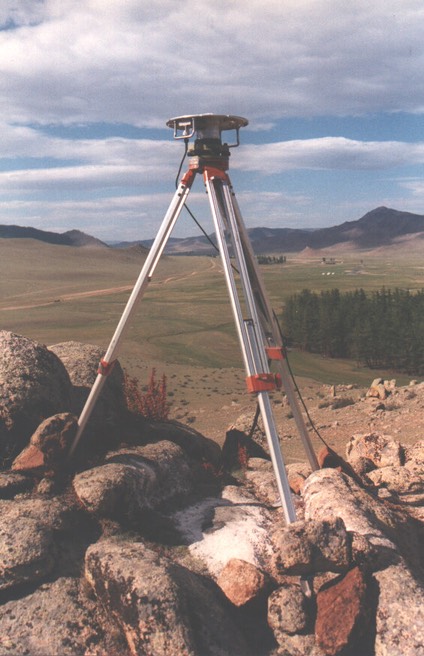
In the late 90's, space-based geodetic techniques such as the Global Positioning System (GPS) reached a level where millimeter-level positioning became achievable globally. In geophysics, GPS measurements have been widely used over the past decade to monitor crustal displacements, with precision levels on the order of a few mm/yr now routinely achieved.
In addition to science applications, GPS has become an essential part of the infrastructure of today's society and represents a significant commercial and job market. Application range from surveying, navigation, transportation, GIS, to geophysics. GPS is now one of several positioning systems grouped under the "Global Navigation Satellite System" (GNSS).
This course will provide a fundamental understanding of the theory and practice of GNSS, with an emphasis on high-precision applications using GPS. Other space geodetic techniques (VLBI, SLR, DORIS) will be mentioned and reference frame issues will be addressed.
The labs will provide hands-on experience in field and data processing techniques, including programming a simple GPS data processing software and learning to use a high-end research software (GAMIT). Prerequisites are working knowledge of Matlab (or fluency in a programming language such as C or Fortran), and a course in linear algebra.
NEW (January 2020): lab notes “from computing satellite orbits to estimating a GPS site position"
Lectures
- Geodesy and Crustal Motions
- Elements of geodesy -- part 1 [pdf]
- Elements of geodesy -- part 2 [pdf]
To read:- Kouba and Popelar, Modern Geodetic Reference Frames [pdf]
- Snay and Soler, Modern Terrestrial Reference Systems: WGS 84 and ITRS [pdf]
- Confused about datums an reference systems? See NGS FAQs about datums.
- The Earth's rotation, paper by J. Wahr [pdf]
- Satellite orbits [pdf]
To read:- "Photons have mass?! I didn't even know they were Catholic" Nice paper on GPS orbits and solar radiation pressure
- "Broadcast vs. precise GPS ephemerides: a historical perspective", by David L.M. Warren and John F. Raquet [pdf]
- GPS observables [pdf]
- GPS signal propagation [pdf]
To read: - GPS parameter estimation [pdf]
- GPS noise models [pdf]
- Reference frames [pdf]
- GPS measurement strategies [pdf]
- Other space geodetic techniques [pdf]
Labs (find solutions here)
- Lab 1: Getting used to Unix/Linux and Matlab [pdf]
See also: Matlab introduction
See also: very short Matlab intro - Lab 2 Coordinate systems [pdf]
- Lab 3: Manipulating sp3 orbits [pdf]
Find igs11376.sp3.Z here
Or download it from SOPAC - Lab 4: From GPS ephemerides to ECEF positions [pdf]
Find epgga2.010.Z here
Find igs11484.sp3.Z here - Lab 5: GPS data quality control [pdf]
Find sjdv0100.02o here
Find PU07200910160000.09o here - Lab 6: Surveying with GPS: field measurements, rinexing and quality control [pdf]
A typical log sheet for campaign measurements
A typical log sheet for continuous measurements
Find TEQC web site here - Lab 7: Pseudorange position solution [pdf]
- Lab 8: Processing a 24-hour RINEX observation file [pdf]
- Lab 9: High-precision processing of GPS data: GAMIT/GLOBK (1/3)
- Lab 10: High-precision processing of GPS data: GAMIT/GLOBK (2/3)
- Lab 11: High-precision processing of GPS data: GAMIT/GLOBK (3/3)
- Lab 12: Term project oral presentations
Term project
Must involve handling and processing of GPS data for a high-precision (cm-level or better) application. You may choose a topic related to your graduate research or something new you are interested in learning more about.
Grading system
Grading will be based on:
- Lab and home work, 30% of grade: Assignments will be given at the beginning of each lab. Any part of the assignment not finished during the lab will be done as homework and must be returned to the TA by the beginning of the next lab session.
- Term project, 30% of grade:
- Written report in the form of a 4-page paper including figures (e.g., format of Geophysical Research Letters). Project reports must include (1) an Introduction section describing the problem to be addressed and its broader significance, (2) a Data section describing the selected GPS data set, (3) an Analysis section describing the analyses of the data set, (4) a Discussion section, describing the results of the data analyses and their implications for the studied problem, and (5) a Conclusion section, summarizing project results.
- 10-minute talk in class at the end of the term (e.g., in the style of an AGU oral presentation).
- Midterm exam, 20% of grade
- Final exam, 20% of grade
Suggested reading
Some fundamental papers on the basics of GPS:
- Hager, B.H., R.W. King, M.H. Murray, Measurement of crustal deformation using the Global Positioning System, Annual Reviews of Earth and Planetary Sciences, 19, 351-382, 1991.
- Dixon, T., The Global Positioning System, Review of Geophysics, 1991.
- Segall, P. and J.L. Davis, GPS applications for geodynamics and earthquake studies, Annual Reviews of Earth and Planetary Science, 25, 301-336, 1997.
- Beutler, G., Satellite Navigation Systems for Earth and Space Sciences.
- Bock, Y., and D. Melgar, Physical applications of GPS geodesy: a review, Rep. Prog. Phys. 79, 2016.
Books:
- GPS, Theory and Practice, B. Hofmann-Wellenhof et al., Springer-Verlag.
- GPS Satellite Surveying, A. Leick, John Wiley and Sons.
- Linear Algebra, Geodesy, and GPS, G. Strang and K. Borre, Wellesley-Cambridge Press.
- Understanding GPS, Principles and applications,Kaplan, Artech House Publishers.
- GPS for Geodesy, Kleusberg and Teunissen (Eds), Springer, 1996.
- A guide to GPS positioning, Wells and coll., Canadian GPS Associates, Univ.New Brunswick, 1996.
A few WWW sites:
- UNAVCO: Promoting Earth Science by advancing high-precision techniques for the measurement of crustal deformation
- International Earth Rotation Service
- International GNSS Service
- National Geodetic Survey
- Nevada Geodetic Laboratory
- Peter Dana's Global Positioning System Overview, a classic.
- A series of GPS courses, by T. Herring (MIT, USA).
- Introduction to Global Navigation Satellite Systems, by K. Larson and P. Axelrad, Univ. Colorado, USA.
- A simple course on GPS positioning, by C. Rizos (Univ. New South Wales, Australia)
- Mike Craymer's collection of GPS resources
- Some useful GPS links.